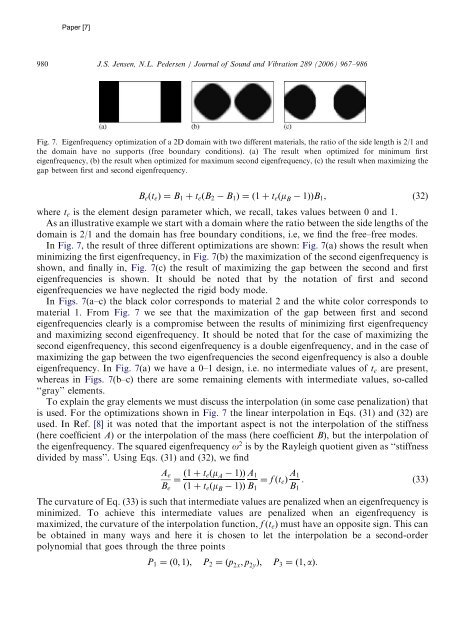WAVES AND VIBRATIONS IN INHOMOGENEOUS STRUCTURES ...
WAVES AND VIBRATIONS IN INHOMOGENEOUS STRUCTURES ...
WAVES AND VIBRATIONS IN INHOMOGENEOUS STRUCTURES ...
Create successful ePaper yourself
Turn your PDF publications into a flip-book with our unique Google optimized e-Paper software.
980<br />
ARTICLE <strong>IN</strong> PRESS<br />
J.S. Jensen, N.L. Pedersen / Journal of Sound and Vibration 289 (2006) 967–986<br />
Fig. 7. Eigenfrequency optimization of a 2D domain with two different materials, the ratio of the side length is 2/1 and<br />
the domain have no supports (free boundary conditions). (a) The result when optimized for minimum first<br />
eigenfrequency, (b) the result when optimized for maximum second eigenfrequency, (c) the result when maximizing the<br />
gap between first and second eigenfrequency.<br />
BeðteÞ ¼B1 þ teðB2 B1Þ ¼ð1 þ teðm B 1ÞÞB1, (32)<br />
where te is the element design parameter which, we recall, takes values between 0 and 1.<br />
As an illustrative example we start with a domain where the ratio between the side lengths of the<br />
domain is 2/1 and the domain has free boundary conditions, i.e, we find the free–free modes.<br />
In Fig. 7, the result of three different optimizations are shown: Fig. 7(a) shows the result when<br />
minimizing the first eigenfrequency, in Fig. 7(b) the maximization of the second eigenfrequency is<br />
shown, and finally in, Fig. 7(c) the result of maximizing the gap between the second and first<br />
eigenfrequencies is shown. It should be noted that by the notation of first and second<br />
eigenfrequencies we have neglected the rigid body mode.<br />
In Figs. 7(a–c) the black color corresponds to material 2 and the white color corresponds to<br />
material 1. From Fig. 7 we see that the maximization of the gap between first and second<br />
eigenfrequencies clearly is a compromise between the results of minimizing first eigenfrequency<br />
and maximizing second eigenfrequency. It should be noted that for the case of maximizing the<br />
second eigenfrequency, this second eigenfrequency is a double eigenfrequency, and in the case of<br />
maximizing the gap between the two eigenfrequencies the second eigenfrequency is also a double<br />
eigenfrequency. In Fig. 7(a) we have a 0–1 design, i.e. no intermediate values of te are present,<br />
whereas in Figs. 7(b–c) there are some remaining elements with intermediate values, so-called<br />
‘‘gray’’ elements.<br />
To explain the gray elements we must discuss the interpolation (in some case penalization) that<br />
is used. For the optimizations shown in Fig. 7 the linear interpolation in Eqs. (31) and (32) are<br />
used. In Ref. [8] it was noted that the important aspect is not the interpolation of the stiffness<br />
(here coefficient A) or the interpolation of the mass (here coefficient B), but the interpolation of<br />
the eigenfrequency. The squared eigenfrequency o2 is by the Rayleigh quotient given as ‘‘stiffness<br />
divided by mass’’. Using Eqs. (31) and (32), we find<br />
Ae<br />
¼<br />
Be<br />
ð1 þ teðmA 1ÞÞ A1<br />
¼ f ðteÞ<br />
ð1 þ teðmB 1ÞÞ B1<br />
A1<br />
. (33)<br />
B1<br />
The curvature of Eq. (33) is such that intermediate values are penalized when an eigenfrequency is<br />
minimized. To achieve this intermediate values are penalized when an eigenfrequency is<br />
maximized, the curvature of the interpolation function, f ðteÞ must have an opposite sign. This can<br />
be obtained in many ways and here it is chosen to let the interpolation be a second-order<br />
polynomial that goes through the three points<br />
P1 ¼ð0; 1Þ; P2 ¼ðp2x; p2yÞ; P3 ¼ð1; aÞ.

















